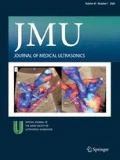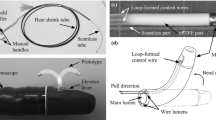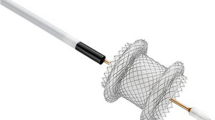Abstract
Purpose
This study was designed to evaluate the feasibility and safety of a newly designed self-expandable metal stent for endoscopic ultrasound-guided biliary drainage (EUS-BD) when it was delivered via three different stent delivery systems: a 7.5Fr delivery catheter with a bullet-shaped tip (7.5Fr-bullet), a 7Fr catheter with a bullet-shaped tip (7Fr-bullet), or a 7Fr catheter with a tee-shaped tip (7Fr-tee).
Methods
This experimental study utilized a porcine model of biliary dilatation involving ten pigs. In the animal study, technical feasibility and clinical outcomes of the stent when placed with each of the delivery systems were examined. In addition, a phantom model was used to measure the resistance of these delivery systems to advancement.
Results
Phantom experiments showed that, compared with 7Fr-bullet, 7Fr-tee had less resistance force to the advancement of the stent delivery system. EUS-BD was technically successful in all ten pigs. Fistulous tract dilation was necessary in 100% (2/2), 75% (3/4), and 0% (0/4) of the pigs that underwent EUS-BD using 7.5Fr-bullet, 7Fr-bullet, and 7Fr-tee, respectively. There were no procedure-related complications.
Conclusion
Our newly designed metal stent may be feasible and safe for EUS-BD, particularly when delivered by 7Fr-tee, because it eliminates the need for fistulous tract dilation.





Similar content being viewed by others
References
Giovannini M, Moutardier V, Pesenti C, et al. Endoscopic ultrasound-guided bilioduodenal anastomosis: a new technique for biliary drainage. Endoscopy. 2001;33:898–900.
Khan MA, Akbar A, Baron TH, et al. Endoscopic ultrasound-guided biliary drainage: a systematic review and meta-analysis. Dig Dis Sci. 2016;61:684–703.
Wang K, Zhu J, Xing L, et al. Assessment of efficacy and safety of EUS-guided biliary drainage: a systematic review. Gastrointest Endosc. 2016;83:1218–27.
Moole H, Bechtold ML, Forcione D, et al. A meta-analysis and systematic review: success of endoscopic ultrasound guided biliary stenting in patients with inoperable malignant biliary strictures and a failed ERCP. Medicine. 2017;96:e5154.
Wang P, Li ZS, Liu F, et al. Risk factors for ERCP-related complications: a prospective multicenter study. Am J Gastroenterol. 2009;104:31–40.
Kawakubo K, Isayama H, Kato H, et al. Multicenter retrospective study of endoscopic ultrasound-guided biliary drainage for malignant biliary obstruction in Japan. J Hepatobiliary Pancreat Sci. 2014;21:328–34.
Vila JJ, Pérez-Miranda M, Vazquez-Sequeiros E, et al. Initial experience with EUS-guided cholangiopancreatography for biliary and pancreatic duct drainage: a Spanish national survey. Gastrointest Endosc. 2012;76:1133–41.
Hara K, Yamao K, Mizuno N, et al. Endoscopic ultrasonography-guided biliary drainage: who, when, which, and how? World J Gastroenterol. 2016;22:1297–303.
Minaga K, Kitano M, Gon C, et al. Endoscopic ultrasonography-guided choledochoduodenostomy using a newly designed laser-cut metal stent: feasibility study in a porcine model. Dig Endosc. 2017;29:211–7.
Minaga K, Kitano M. Recent advances in endoscopic ultrasound-guided biliary drainage. Dig Endosc. 2017. https://doi.org/10.1111/den.12910.
Park DH, Jang JW, Lee SS, et al. EUS-guided biliary drainage with transluminal stenting after failed ERCP: predictors of adverse events and long-term results. Gastrointest Endosc. 2011;74:1276–84.
Martins FP, Rossini LGB, Ferrari AP. Migration of a covered metallic stent following endoscopic ultrasound-guided hepaticogastrostomy. Endoscopy. 2010;42:E126–7.
Okuno N, Hara K, Mizuno N, et al. Stent migration into the peritoneal cavity following endoscopic ultrasound-guided hepaticogastrostomy. Endoscopy. 2015;47:E311.
Minaga K, Kitano M, Yamashita Y, et al. Stent migration into the abdominal cavity after EUS-guided hepaticogastrostomy. Gastrointest Endosc. 2017;85:263–4.
Lakhtakia S. Complications of diagnostic and therapeutic endoscopic ultrasound. Best Pract Res Clin Gastroenterol. 2016;30:807–23.
Isayama H, Kawakubo K, Nakai Y, et al. A novel, fully covered laser-cut nitinol stent with antimigration properties for nonresectable distal malignant biliary obstruction: a multicenter feasibility study. Gut Liver. 2013;7:725–30.
Minaga K, Kitano M, Imai H, et al. Evaluation of anti-migration properties of biliary covered self-expandable metal stents. World J Gastroenterol. 2016;22:6917–24.
Itoi T, Isayama H, Sofuni A, et al. Stent selection and tips on placement technique of EUS-guided biliary drainage: transduodenal and transgastric stenting. J Hepatobiliary Pancreat Sci. 2011;18:664–72.
Rustemovic N, Cukovic-Cavka S, Opacic M, et al. Endoscopic ultrasound elastography as a method for screening the patients with suspected primary sclerosing cholangitis. Eur J Gastroenterol Hepatol. 2010;22:748–53.
Itoi T, Binmoeller KF, Shah J, et al. Clinical evaluation of a novel lumen-apposing metal stent for endosonography-guided pancreatic pseudocyst and gallbladder drainage (with videos). Gastrointest Endosc. 2012;75:870–6.
Walter D, Teoh AY, Itoi T, et al. EUS-guided gall bladder drainage with a lumen-apposing metal stent: a prospective long-term evaluation. Gut. 2016;65:6–8.
Kunda R, Pérez-Miranda M, Will U, et al. EUS-guided choledochoduodenostomy for malignant distal biliary obstruction using a lumen-apposing fully covered metal stent after failed ERCP. Surg Endosc. 2016;30:5002–8.
Acknowledgements
The present study was supported by grants from the Research and Development Committee Program of The Japan Society of Ultrasonics in Medicine, and the Japan Society for the Promotion of Science (Grant No. 16K09410). Piolax Medical Devices, Inc. provided stent samples. The funders did not participate in the study design; the collection, analysis, and interpretation of the data; the writing of the report; or the decision to submit the article for publication. We would also like to thank Jun Sumiya and Kyosuke Shirakawa of Piolax Medical Devices, Inc. (Yokohama, Japan) for their efforts in developing the newly designed metal stent.
Author information
Authors and Affiliations
Contributions
All authors helped to perform the research; Kosuke Minaga: manuscript writing and performing experiments; Masayuki Kitano: conception and design of the study, performing endoscopic procedures, and data analysis; Masahiro Itonaga, Hajime Imai, Takeshi Miyata, Kentaro Yamao, Takashi Tamura, and Junya Nuta: performing experiments and data analysis; Kenji Warigaya: pathological assessment; Masatoshi Kudo: conception and design of the study, assistance in writing the manuscript.
Corresponding author
Ethics declarations
Conflict of interest
The following authors declare no conflicts of interest: K. Minaga, M. Kitano, M. Itonaga, H. Imai, T. Miyata, K. Yamao, T. Tamura, J. Nuta, K. Warigaya, and M. Kudo.
Ethical statements
All institutional and national guidelines for the care and use of laboratory animals were followed.
About this article
Cite this article
Minaga, K., Kitano, M., Itonaga, M. et al. Endoscopic ultrasound-guided biliary drainage using a newly designed metal stent with a thin delivery system: a preclinical study in phantom and porcine models. J Med Ultrasonics 45, 391–397 (2018). https://doi.org/10.1007/s10396-017-0850-1
Received:
Accepted:
Published:
Issue Date:
DOI: https://doi.org/10.1007/s10396-017-0850-1




